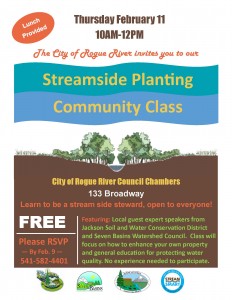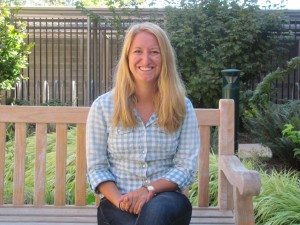By Elisa Dawson
Along a beautiful stretch of the Rogue River is the River’s namesake, the City of Rogue River. The river is a predominant feature of the city, and you can see how people here value the Rogue River though the murals which feature it, the fisherman on the river, and the way residents speak of the river. For me, the River was the driving force in my move here. I love water in all forms, and if I had to choose a favorite river it would be the Rogue.
As luck would have it, the RARE AmeriCorps position I served in enables me to work directly in areas of water quality through helping the City of Rogue River meet their Total Maximum Daily Load (TMDL) requirements. A TMDL permit is issued to cities by the Oregon Department of Environmental Quality. TMDL permits establish water quality standards and establishes the maximum amount of an impairing substance that a waterbody can assimilate to. Part of this permit is not only about controlling pollution, but also requires Cities to perform outreach and education around water and water quality within their communities.
Upon arriving in Rogue River, it was part of my charge to establish and effectuate some of these outreach and education activities. One partnership I created was with the local Elementary School. I was able to me et with two fifth grade teachers who were interested in having their students participate in a project with the City. Through our meeting, we came up with having the students work on a water quality project on their school grounds. We partnered with a kindergarten teacher who had recently acquired funds to build a Monarch Butterfly Wayfinding Station and began brainstorming ways to turn this Monarch Butterfly Wayfinding Station into an outdoor classroom, incorporating water conservation and water quality techniques into the Monarch Butterfly Wayfinding Station project.
et with two fifth grade teachers who were interested in having their students participate in a project with the City. Through our meeting, we came up with having the students work on a water quality project on their school grounds. We partnered with a kindergarten teacher who had recently acquired funds to build a Monarch Butterfly Wayfinding Station and began brainstorming ways to turn this Monarch Butterfly Wayfinding Station into an outdoor classroom, incorporating water conservation and water quality techniques into the Monarch Butterfly Wayfinding Station project.
The 5th graders worked through several educational classes related to water quality. One session included having the students make a “Recipe for Healthy Soil” where they learned about what percentages of sand, silt, clay, air, and water make a soil ideal. The students also calculated how much water would run off of their school roof in a 1 inch rainstorm. For their final project, all of the 5th graders from the two classes at Rogue River Elementary got their hands dirty and participated in planting over 100 native plants at the Fleming Park Riparian Demonstration and Learning Site, as part of a project I was able to secure grant funds for as a RARE AmeriCorps participant in Rogue River.
Education and outreach can sometimes feel like a daunting task with a project, and can often lead to question like “where should I start?” Creating partnerships is key to this process. In Rogue River, by cold calling a few teachers I was able to create a yearlong project for students to be involved in. It has been a highlight of my service for me to be able to teach these young citizens about water quality, and about what their city is doing to try to protect water quality. For most of them, this is their first opportunity to participate directly in local government. My goal is to help the students feel enabled to participate in local government in their future, and even inspire them to become environmental stewards in the process.
Elisa Dawson
Elisa received her bachelor’s degree in both Geography and in Community, Environment, and Planning with a minor in Global Health from the University of Washington. As a student, Elisa worked with the King County Department of Parks and Natural Resources in Seattle, WA, where she worked to support outreach and communication on natural resources and King County programs to diverse communities. After attaining her bachelor’s degree, Elisa served in AmeriCorps at Purgatoire Watershed Partnership in Trinidad, CO, where she designed and executed resource planning and public engagement documents such as the Purgatoire River Watershed Plan, the Community Wildfire Protection Plan, and the City of Trinidad Source Water Protection Plan. Elisa spent a second year of service with the City of Rogue River via the RARE AmeriCorps Program where she conducted long range land use planning projects and assisted with public works water quality projects. Elisa recently accepted a job as a Planner for Snohomish County Surface Water Management in Washington State where she is working with the Shellfish Protection program and the Marine Resources program, doing regional water quality studies, partnership building, and restoration work throughout the north Puget Sound.

